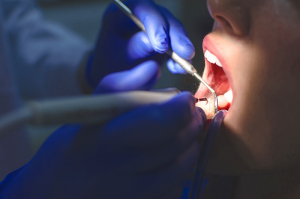By Dr. Salina Suy
 Editor’s note: This is another segment in a continuing series titled “Defining Dentistry,” designed to enlighten readers on various components of dentistry.
Editor’s note: This is another segment in a continuing series titled “Defining Dentistry,” designed to enlighten readers on various components of dentistry.
Happy November everyone!
Thank you for joining me again in this month’s “Smile with Dr. Suy” segment.
I love all the positive feedback at the offices. It is so great to hear people love to learn about the exciting field of dental medicine.
I hope everyone is enjoying the “Defining Dentistry” series. Today, we talk about the epic “tooth pull.” It is quite similar to the Century Smile Dental offering tooth removal procedure. However, with an expert dentist’s assistance, nothing is difficult.
What really is the dentist doing during a tooth extraction? Let’s find out.
A tooth extraction is the procedure in which a tooth is taken out of its socket from the jawbone. It is a form of oral surgery in the field of dental medicine.
According to the best dentists, there are several reasons why your tooth may need to be extracted.
Among those reasons are:
— Impaction: Teeth are stuck underneath in the jaw. This usually occurs because of crowding or lack of space in the bone. Third molars (wisdom teeth), particularly the lowers, are the last to erupt and are more likely to be impacted.
— Wisdom teeth: Most troublesome if they are causing pain or problems within the jaw. If this is the case, your dentist may recommend wisdom teeth extraction.
— Orthodontic treatment: To make room for straightening of the teeth
— Fracture below the gum line, which makes the tooth difficult to restore, particularly if completely broken
— Severe bone loss: Periodontal disease; smoking can increase bone loss
— Dental abscess: Infection in the gum due to various reasons
— Trauma: Traumatic injury like damages as a result of falling
— Dental decay: Cavities that are large and cause other problems
What are surgical risks?
A problem called a dry socket can develop. This occurs when a blood clot doesn’t form in the hole or the blood clot breaks off or breaks down too early. It results in bone pain and unfortunately can only be partially treated until the tissue heals over the site.
Caution: Dry socket is very painful, so it is vital to follow post-op directions closely.
Other risks include:
— Accidental damage to nearby teeth, such as a fracture of fillings or teeth
— An incomplete extraction, In which a tooth root remains in the jaw
— Fractured jaw: Occurs in rare cases and usually on frail patients with known bone disease
— A hole in the sinus during removal of an upper back tooth (molar)
— Soreness in the jaw muscles and/or jaw joint
— Long-lasting numbness in the lower lip and chin. An injury to a nerve may occur in rare instances. Complete healing may take three to six months. In rare cases, the numbness may be permanent.
What is procedure like?
Tooth extraction procedures can vary depending on a patient’s clinical case.
Patients will always need some form of local anesthesia to numb the area. This has been done typically with novocaine, but doctors are using lidocaine now along with other derivatives.
After you are numb, your dentist will test the area. Pressure and pulling sensations are normal to feel during the procedure; pinching is not. Dental instruments are used to elevate the tooth and forceps to grasp the tooth out of its socket. During the procedure, a bur may be used to cut hard tissues, whether it be tooth or bone, to increase access the area. You may or may not be awake — most procedures can be tolerated without sedation.
Sedation is recommended by a sedation dentistry specialist for some patients if they have a complex procedure, have dental anxiety or request to be “knocked out.” The most common types of sedation dentistry include oral conscious sedation and intravenous (IV) sedation.
With oral conscious sedation, your dentist gives you sedative medication about an hour before your procedure begins. Oral sedation makes you quite groggy, and you may even fall asleep. But you’ll still be able to communicate with your dentist if necessary, and you’ll awaken with a gentle nudge.
IV sedation dentistry is the deepest form of conscious sedation available in a dental office setting. Your IV sedation dentist delivers sedative medications directly to your bloodstream through an IV line. Most people who receive IV sedation dentistry fall asleep and have little to no memory of their treatment when they wake up. This option is best for people with severe dental anxiety or those who are undergoing lengthy procedures.
Sometimes, teeth need to be taken out. When teeth are taken out that need to be replaced, there are many options to do so. If you need a tooth pulled, rest assured the procedure isn’t as bad as the movies make it.
What matters most is that you trust the doctor who is doing your procedure.
• Dr. Salina Suy is a health and wellness advocate and general dentist in Utica. Want to learn more? Visit Facebook @smilewithdrsuy or www.smilewithdrsuy.com.

